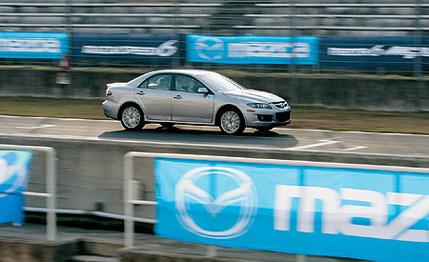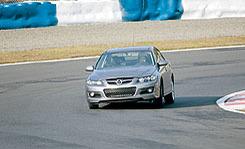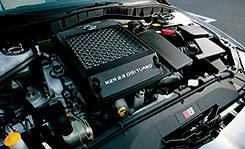 First Drive Review
First Drive Review
The specs--274 horsepower, 280 pound-feet of torque, all-wheel drive, 3500 pounds--suggest that the bad-boy-sedan class will soon be a trio: Mitsubishi Lancer Evo, Subaru Impreza WRX STi, and Mazdaspeed 6. Not so fast, says Mazda, a caution that may be quite literal. This warmed-up mid-size sedan figures to be the hottest four-door the company has ever offered, but its creators are quick to point out that the program objectives are broader than mere hard-edged performance. Think Subaru Legacy GT, or Acura TL.
"We didn't want to do one of these off-the-rally-route-and-onto-the-street type of cars," said Peter Birtwhistle, a man who helped write the mission statement. He's chief of Mazda's advanced design studio in Germany, the source of the Mazda 6 MPS concept unveiled at the '02 Paris show and the inspiration for the production model.
The Paris concept was based on the Mazda 6 five-door hatchback, but the development team chose the lighter (by about 100 pounds) four-door sedan for production. Aside from that, though, the car is true to the suggestion established in '02: a generous helping of turbo power flowing to all four wheels, and a soupçon of attitude in its couture. Voilà! Formidable!
Then again, formidable may be a little too much adjective, a suspicion that manifested itself in Mazda's 0-to-60-mph forecast--6.2 seconds compared with 4.8 for the Evo MR and 4.9 for the Subaru STi that we tested [see "Bad-Boy Sedans,"]. Even though we think the 6 is quicker than Mazda's forecast, suspicion later hardened to near certainty after a few laps at a racetrack near Okayama, Japan. We can't draw definitive conclusions until a testable model gets to Ann Arbor come spring, but the Mazdaspeed people say it's not a track car, and we believe them.

So that's what it's not. Then what it is? Quoting from the preview hymnal, it is "the highest-performing, best-handling sedan Mazda has ever built," or, more succinctly, "the ultimate Zoom-Zoom sedan." None of which tells you much about the hardware. Let us review the elements of Zoom.
Starting with the basic Mazda 6 structure--a unibody with good rigidity credentials--Mazda added a cross brace behind the rear seats and a hefty cross-body beam under the dash, heavied up the mounting points for the front and rear suspension subframes, and beefed the A-pillar anchor points. The net of the foregoing, according to Mazda, is a 50-percent gain in torsional rigidity. Sounds extravagant, but we failed to pack a structural-rigidity test rig and thus must take the company's word for it.
As you'd expect, the suspension--unequal-length control arms in front, a multilink rear--has been stiffened, with higher spring rates, firmer shock damping (monotube at the rear), harder bushings, and heftier anti-roll bars fore-and-aft. Heftier also applies to the brakes, which spin behind 7.0-by-18-inch alloy wheels (versus 7.0-by-17 on the Mazda 6 s).
Power is supplied by a revised Mazda MZR 2.3-liter DOHC 16-valve four, said revisions including a block cast from higher-density aluminum alloy; a reduced compression ratio (9.5:1 versus 9.7:1); a steel crankshaft with enlarged crankpins; direct (versus port) fuel injection, a first for a U.S. Mazda; and a Hitachi turbocharger compressing the air-fuel mixture to the tune of 15.6 psi via an air-to-air intercooler mounted squarely atop the engine.

The force-fed engine delivers its increased output (114 more horsepower than the naturally aspirated four, 54 more than the 6's optional 3.0-liter V-6) through a slick new Aisin six-speed manual gearbox to Mazda's equally new Active Torque Split All-Wheel Drive. It's a computer-automated system, delivering up to 50 percent of the engine's power to the rear wheels contingent on variables such as wheelspin, yaw, and steering angle, with a limited-slip diff up front and an electric clutch at the rear. There's no center diff. The system has three operating modes--normal, sport, and snow--but unfortunately, the computer decides which is appropriate for conditions and driving style. There are no manual preselects.
Cosmetic distinctions are subtle. The most visible, aside from the wheel design, is the hoodline, which has been raised 1.8 inches to accommodate the intercooler. The grille is a little bigger, with an opening above its central trim bar to gulp intercooler air. The design team scorned a hood scoop--too boy-racerish--and in the same vein, the rear spoiler is less visible than the rear wing on the 6 s. The front fenders and the bumper fascia are also new, as are the slightly deeper rocker extensions. Interior upgrades are even more subtle--dark trim on the center stack versus the aluminum-look brightwork of the 6 s, a higher-grade leather wrap for the steering wheel, rear-seat headrests, and slightly sportier leather buckets.
Dynamics. Six laps on a racetrack isn't a road test, but a few impressions emerge. First, the defining trait of the Mazdaspeed 6 is understeer. The all-wheel-drive system enhances corner exits, but it's hard to think of this car as nimble. On the other hand, the turbo four delivers nice midrange punch, the gearbox is Honda-precise, the steering is accurate, the braking strong, and if the suspension seems soft by Evo and STi standards, it should provide good ride quality. More tire footprint might help the handling, but the car does have the virtue of total predictability.
Mazda wasn't ready to discuss pricing, other than a ballpark $28,000. Nav, leather, and a sunroof are optional. Beyond that, the Mazdaspeed version of this mainstream sedan seems to be the most definitive expression of Zoom-Zoom we've seen, stopping well short of all-out performance. Maybe Mazda should use a lower-case z.